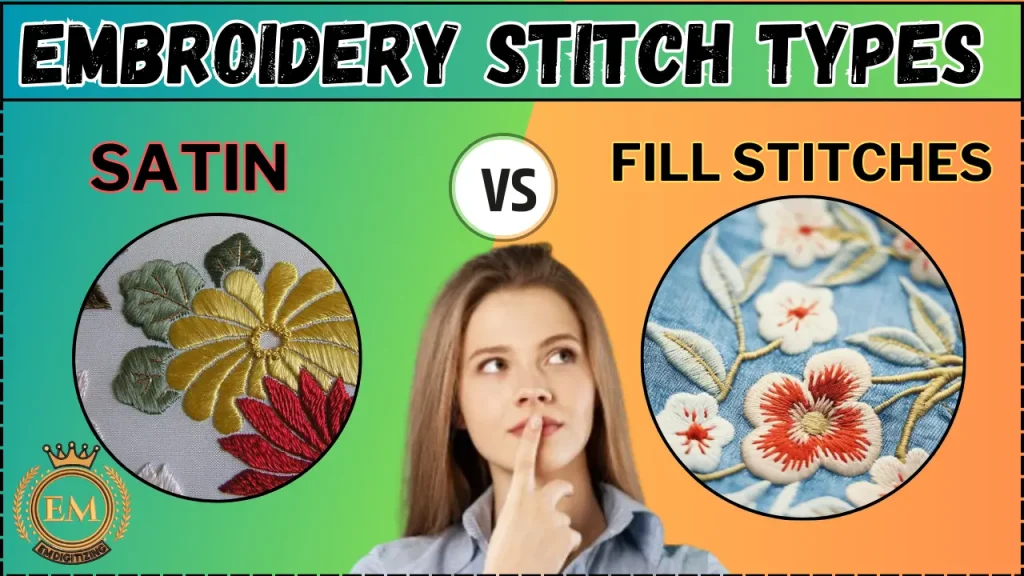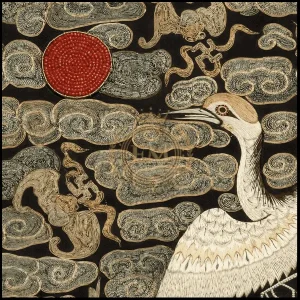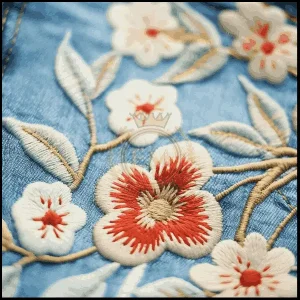Maschinenstickerei ist eine faszinierende Kunstform, die die Erstellung komplizierter und detaillierter Designs auf verschiedenen Stoffen und Kleidungsstücken ermöglicht. Zwei beliebte Sticharten in der Maschinenstickerei sind der Satinstich und der Füllstich.
In diesem Artikel, Wir werden uns mit den Feinheiten von Satin- und Füllstichen befassen, Entdecken Sie ihre einzigartigen Eigenschaften, Vergleichen Sie ihr Aussehen und ihre Textur, Besprechen Sie ihre vielfältigen Einsatzmöglichkeiten, und bieten Einblicke in Faktoren, die bei der Wahl zwischen ihnen zu berücksichtigen sind.

Egal, ob Sie Anfänger oder erfahrener Maschinensticker sind, Dieser Artikel bietet wertvolle Einblicke in die Unterscheidung zwischen Satin- und Füllstich in der Maschinenstickerei.
Sticksticharten: Satin vs. Füllstich erklärt
Die Technik verstehen: Plattstich
Der Satinstich ist ein grundlegender und vielseitiger Stich Sticktechnik bekannt für seine Geschmeidigkeit, glänzendes Aussehen.
Definition und Eigenschaften des Satinstichs
EIN Plattstich ist eine Technik, bei der parallele Stiche nebeneinander platziert werden, um einen Bereich vollständig abzudecken.

Die Stiche liegen dicht beieinander, sorgt für ein glattes und glänzendes Finish, erinnert an Satinstoff. Satinstiche sind typischerweise lang und schmal und werden oft zum Erstellen von Konturen verwendet, Beschriftung, und aufwendige Details.
So entsteht ein Satinstich?
So erstellen Sie einen Satinstich, Die Maschine bewegt sich geradlinig hin und her, wobei die Nadel bei jedem Durchgang in den Stoff eindringt.
Die Stiche werden dicht nebeneinander platziert, um eine vollständige Abdeckung des zu füllenden Bereichs zu gewährleisten. Die Länge und Breite der Stiche können angepasst werden, um unterschiedliche Effekte zu erzielen.
Faktoren, die die Satinstichqualität beeinflussen
Um einen hochwertigen Satinstich zu erzielen, ist Liebe zum Detail erforderlich. Faktoren wie Fadenspannung, Maschendichte, Die Auswahl des Stabilisators kann sich auf das Endergebnis auswirken.
It’;Es ist wichtig, das zu wählen richtige Fadenstärke und Typ für den Stoff verwendet wird, sowie ordnungsgemäß stabilisieren Stoff, um ein Falten zu verhindern oder Verzerrung.
Erkundung der Technik: Stich füllen
Füllstich, eine weit verbreitete Sticktechnik, ist unerlässlich, um einem Design solide Farb- oder Strukturbereiche hinzuzufügen.
Definition und Eigenschaften von Füllstichen
Füllstich, wie der Name schon sagt, wird verwendet, um größere Bereiche innerhalb eines Designs auszufüllen. Im Gegensatz zu einem Satinstich, die aus einzelnen, dicht aneinander liegenden Stichen besteht, Ein Füllstich erzeugt einen Volumenkörper, Kontinuierliche Füllung durch Zusammennähen von Maschenreihen oder -spalten in einem Muster.

Füllstiche können unterschiedlich dicht sein und werden häufig für Hintergründe und größere Formen verwendet.
So entsteht ein Füllstich?
So erstellen Sie einen Füllstich, das Stickmaschine näht Reihen oder Spalten mit eng beieinander liegenden Stichen innerhalb des vorgesehenen Bereichs. Die Stiche können gerade oder abgewinkelt sein, je nach gewünschtem Effekt. Der Abstand zwischen den Stichen kann sein angepasst, um die Dichte zu steuern der Füllung.
Faktoren, die die Füllstichqualität beeinflussen
Um einen sauberen und gleichmäßigen Füllstich zu erhalten, müssen Faktoren wie die Stichrichtung sorgfältig berücksichtigt werden, Stichlänge, und Stoffspannung.
Gleichbleibende Abstände und die richtige Fadenspannung sind entscheidend, um Lücken oder Bündelungen innerhalb der Füllung zu verhindern. Auch die Wahl des richtigen Stichwinkels kann das Erscheinungsbild des Motivs beeinflussen.
Vergleich von Satin- und Füllstichtechniken
Der Vergleich von Satinstich- und Füllstichtechniken in der Stickerei gibt Einblicke in ihre einzigartigen Eigenschaften und Anwendungen.
Unterschiede in Aussehen und Textur
Der Satinstich sorgt für ein glattes und glänzendes Finish, Ideal für detaillierte Konturen und Beschriftungen. Andererseits, Der Füllstich sorgt für ein solides und substanzielles Erscheinungsbild, Perfekt zum Füllen größerer Flächen und zum Erstellen von Texturen.

Die Wahl zwischen Satinstich und Füllstich hängt von der gewünschten Optik und Haptik Ihres Stickdesigns ab.
Variationen in der Designflexibilität
Der Satinstich bietet mehr Flexibilität beim Erstellen feiner Linien, Kurven, and intricate shapes due to its ability to closely follow the design’;s Konturen. Füllstich, obwohl es in dieser Hinsicht nicht so vielseitig ist, bietet den Vorteil, größere Flächen schneller abzudecken.

Berücksichtigen Sie bei der Wahl zwischen den beiden Techniken die Komplexität Ihres Entwurfs und den gewünschten Detaillierungsgrad.
Überlegungen zur Stichdichte und -länge
Beim Satinstich sind längere Stiche erforderlich, um ein glatteres Finish zu erzielen, Ein zu langer Stich kann jedoch dazu führen, dass sich der Stoff kräuselt. Füllstich, auf der anderen Seite, können enger zusammengenäht werden, um ein dichteres Erscheinungsbild zu erzielen.

Berücksichtigen Sie die Stoffart, Designgröße, und gewünschten Effekt bei der Bestimmung der geeigneten Stichdichte und -länge für Ihr Stickprojekt.
Erinnern, Sowohl der Satin- als auch der Füllstich haben ihre Stärken und können in Kombination verwendet werden, um dynamische und optisch ansprechende Ergebnisse zu erzielen Maschinenstickerei-Designs.
Experimentieren Sie mit verschiedenen Techniken, um Ihren persönlichen Stil zu entdecken und Ihrer Kreativität freien Lauf zu lassen!
Zu berücksichtigende Faktoren bei der Wahl zwischen Satin- und Füllstich
Bei der Entscheidung, ob Sie bei Ihrer Maschinenstickerei Satin- oder Füllstiche verwenden möchten, Es sind einige Faktoren zu berücksichtigen.
Stil und Design der Stickerei
Der Stil und das Design Ihres Stickprojekts spielen eine wichtige Rolle bei der Entscheidung, ob Sie einen Satin- oder Füllstich verwenden.

Der Satinstich ist perfekt, um eine glatte Oberfläche zu erzeugen, schlanke Linien und Formen, Der Füllstich eignet sich besser zum Füllen größerer Flächen mit Volltonfarbe oder Textur. Berücksichtigen Sie die Komplexität und Komplexität Ihres Designs, um zu bestimmen, welcher Stich es am besten zum Leben erweckt.
Stofftyp und Textur
Another important factor to consider is the type and texture of the fabric you’;Ich werde weitersticken. Der Satinstich eignet sich gut für glatte und leichte Stoffe, wie Seide oder Satin, da es sanft über die Oberfläche gleiten kann.
Andererseits, strukturierte oder dickere Stoffe, wie Denim oder Fleece, kann von einem Füllstich profitieren, wodurch mehr Dimension und Abdeckung geschaffen werden kann.
Gewünschtes Endergebnis und Haltbarkeit
Denken Sie über das gewünschte Endergebnis nach Ihr Stickprojekt und deren Verwendungszweck. Der Satinstich kann Ihren Designs ein elegantes und elegantes Aussehen verleihen, Dadurch eignet es sich für dekorative Stücke oder detaillierte Verzierungen.

Jedoch, wenn es auf die Haltbarkeit ankommt, Ein Füllstich ist möglicherweise die bessere Wahl, da es aufgrund seiner dichten und robusten Beschaffenheit einer höheren Beanspruchung standhält.
Anwendungen und Beispiele von Satin- und Füllstichen in der Maschinenstickerei
Satin- und Füllstiche haben verschiedene Anwendungsmöglichkeiten in der Maschinenstickerei, und hier sind ein paar Beispiele:
Verschönern von Kleidung und Accessoires
Mit dem Satinstich lassen sich Kleidung und Accessoires verschönern, B. das Hinzufügen komplizierter Details an einem Kragen oder das Hervorheben einer Tasche.

Füllstich, auf der anderen Seite, eignet sich perfekt zum Füllen größerer Flächen wie des Taschenkörpers oder der Vorderseite eines Sweatshirts, um auffällige Designs zu kreieren.
Erstellen von Texten und Logos
Bei der Erstellung von Texten und Logos werden häufig sowohl Satin- als auch Füllstiche verwendet. Der Satinstich verleiht Buchstaben und kleinen Details ein elegantes und professionelles Aussehen

Füllstiche hingegen können verwendet werden, um den Hintergrund zu füllen und den Text oder das Logo hervorzuheben.
Hinzufügen von Textur und Dimension zu Designs
Füllstiche eignen sich hervorragend, um Designs Textur und Dimension zu verleihen. Damit lassen sich realistische Effekte erzeugen, B. das Nachbilden von Fell oder das Hinzufügen eines 3D-Effekts zu Blütenblättern.
Plattstich, auf der anderen Seite, kann zum Umreißen und Definieren dieser strukturierten Bereiche verwendet werden, verleiht dem Design ein poliertes Finish.
Fazit zu Satin vs. Füllstich in der Maschinenstickerei
Abschließend, Sowohl der Satin- als auch der Füllstich haben ihre einzigartigen Anwendungen und Stärken in der Maschinenstickerei. Berücksichtigen Sie den Stil Ihres Designs, the fabric you’;Ich arbeite mit, und das gewünschte Endergebnis, um zu bestimmen, welcher Stich verwendet werden soll.
Mit Richtiger Thread und Nadelauswahl, Gewebestabilisierung, und Maschineneinstellungen, Mit beiden Stichen können Sie hochwertige Ergebnisse erzielen.
Also mach weiter, Viel Spaß beim Experimentieren, und lassen Sie Ihrer Kreativität bei Ihren Maschinenstickprojekten freien Lauf!
EMdigitalisieren: Experte für die Digitalisierung von Stickereien zu Ihren Diensten
Wenn Sie an einem Stickprojekt jeglicher Art interessiert sind, Dann ist EMdigitizing die beste Option für Sie. Wir bieten Stickerei digitalisieren und Vektorkunstdienste mit einer schnellen Bearbeitungszeit. Sie können auch unsere Website besuchen und sich über unsere besten Dienstleistungen informieren.
Wir bieten auch ein tolles 50% Rabatt auf alle unsere Dienstleistungen für unsere angesehenen Erstkunden. Wir bieten auch an kostenlose Angebote in gerade erzeugt 5 Protokoll.
Schnappen Sie sich dieses zeitlich begrenzte Angebot und bringen Sie Ihr Stickprojekt mit EMdigitizing auf die nächste Stufe.
Wenn Sie Fragen zu diesem Thema haben, du kannst sie fragen. Vielen Dank, dass Sie sich die Zeit genommen haben, diesen Artikel zu lesen.
Häufig gestellte Fragen:
Der Satinstich wird oft als der beste Stich zum Füllen von Flächen in Stickereien angesehen, da es eine glatte Oberfläche erzeugt, dicht, und gleichmäßige Abdeckung. Dieser Stich ist ideal, um größere Flächen glatt abzudecken, glänzende Textur, Dies macht es zu einer beliebten Wahl für das Hinzufügen von einfarbigen Farbblöcken.
Der Bullion-Knoten gilt allgemein als einer der schwierigsten Stickstiche. Es erfordert ein präzises Umwickeln des Fadens um die Nadel und ein vorsichtiges Zurückführen durch den Stoff, Dies macht es schwierig, einheitliche und saubere Ergebnisse zu erzielen, besonders für Anfänger.
Der Laufstich ist normalerweise der einfachste und einfachste Stickstich. Dabei handelt es sich um einfache Ein- und Ausstiche, die eine gestrichelte Linie auf dem Stoff bilden. Dieser Stich ist grundlegend beim Sticken und oft der erste Stich, den Anfänger erlernen.
Der Rückstich ist für seine Stärke und Haltbarkeit bekannt. Es überlappt Stiche auf der Rückseite des Stoffes, Dadurch ist es robust und ideal für Umrisse oder Details, die mehr strukturelle Integrität in einem Stickdesign erfordern.
Die ideale Stichlänge beim Sticken variiert je nach Stichart und gewünschtem Effekt. Allgemein, eine Länge von 1/16 zu 1/8 Zoll (um 1.5 zu 3 mm) ist für feinere Details üblich, während längere Stiche für Füll- oder Dekorationszwecke verwendet werden können. Der Schlüssel liegt in der gleichmäßigen Länge für ein ordentliches und einheitliches Erscheinungsbild.
